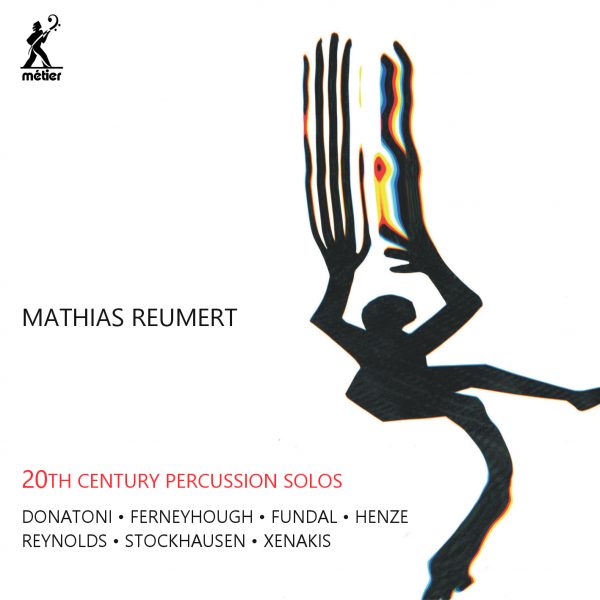Fanfare
Percussionist Mathias Reumert’s DVD of contemporary percussion works impressed me in Fanfare 40:4; here it is again, in sound only, as the backbone of this release, but with some added pieces. And, a couple of subtractions: Pierre Jodlowski’s Time & Money goes, presumably because the composer there actually has video as a defined part of his piece, and Globokar’s ?Corporel actually used Reumert’s face as a percussion instrument (again, one can see why a video of that appeals).
Most notable of the additions is the first piece we hear, a new recording of Stockhausen’s Zyklus (1959). The title means ‘cycle’ and refers to the cycles of events allotted to the 13 different types of percussion instruments, including Indian bells, African wood drums, and cowbells. Carefully organized cycles of sound colors are reflected in the processional of the percussionist around the circle of instruments. A multitude of performance options gives the interpreter a truly creative hand. Composed in 1959 (when the composer was working also on the first stages of Kontakte), Zyklus comprises nine different layers held in a structure of 17 equidurational periods; the score can be started at any point and even read upside down. Notation varies from the very precise to pitch complexes, or what might be called ‘fields’. As Reumert says in his notes, “Zyklus isn’t easy, but it sure as hell is fun.” And Reumert certainly does seem to give his all. On headphones, the sense of the arrangement of percussion in space is clear, although it would need to be surround sound to get the full circular experience.
On to Donatoni and the late, two-movement work for vibraphone called Omar (1985). The piece has clear personal meaning for Reumert (he memorized it for the Concours International de Vibraphone in Clermont-Ferrand, France). There is something magical about the sound of a vibraphone as caught on this perfect recording: on headphones in particular it is so impeccably precise and glacial in the first movement; the second is more dream-like.
The “B/A” aspect of the title for Xenakis’s Rebonds (1989) refers to the movement order. The second (“B”) movement includes woodblocks as well as the prevailing five bongos and five drums. This is a virtuoso performance (as, in fact, is everything on the disc, but that aspect seems particularly apparent here). The recording was done in a single take and certainly has a visceral sense of excitement about it.
Another addition to the DVD program is Danish composer Karsten Fundal’s Möbius #1 (2001), intended as a sort of palette cleanser between the twin Xenakis saturation-fests. Interweaves of pat¬terns, inspired by a Möbius strip, form the basis of this eminently appealing work, played with al¬most a sense of innocence by Reumert. Written in 1975, Xenakis’s seminal Psappha uses 16 sound sources, nine of which are skin or wooden and the remaining seven metal. Each group is further sub¬divided within itself to create groups that can work against each other in opposition. Once more, Reumert’s technical mastery is never once in doubt. Xenakis’s music demands stamina, technical excellence and, importantly, pure belief, qualities Reumert has in abundance.
The sheer sonic beauty of the Henze and the dance backdrop to Ferneyhough’s Bone Alphabet (1991) work well, although once one has seen the glow-in-the-dark color sticks of the Ferneyhough video, it does feel a little like something is missing. Perhaps that is an instance of an idea being a little too successful. Finally, there comes the last addition, Roger Reynolds’s half-hour piece Watershed (1994). This composition in live performance has a heavily gestural aspect, which is obviously cut out for a sound-only release. There are various divisions of the percussionist’s armory, including “Skins” and “Metals,” as well as “Oddities” and “Critics,” boxes that exist outside of the normal playing field and whose function it is to comment. There are also “Rain” sections, periods of repose. This is a fairly extended piece, in which transformations unfold over a large canvas. Here, as everywhere, Reumert is a paragon of excellence. His vitality and commitment are inspirational; recommended.
@divineartrecordingsgroup
A First Inversion Company
Registered Office:
176-178 Pontefract Road, Cudworth, Barnsley S72 8BE
+44 1226 596703
Fort Worth, TX 76110
+1.682.233.4978












